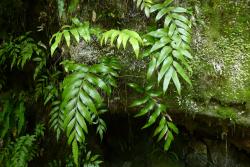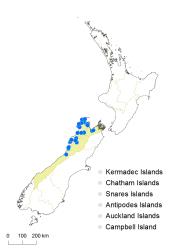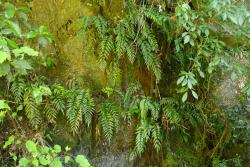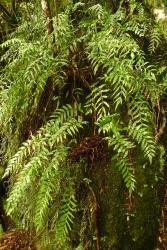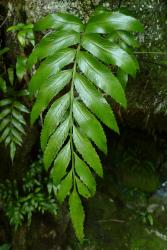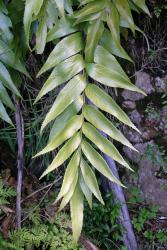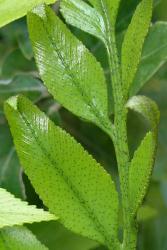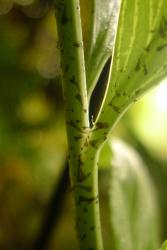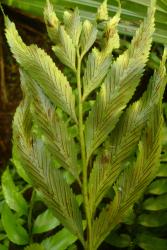Rupestral or rarely epiphytic ferns. Rhizomes stout, usually erect, rarely short-creeping, bearing scales. Rhizome scales ovate or narrowly ovate, 10–30 mm long, 2–5 mm wide, dark brown, clathrate. Fronds 120–1100 mm long. Stipes 43–600 mm long, green or brown, densely to sparsely covered throughout in narrowly ovate or ovate scales with acute or acuminate or filiform apices. Rachises often green on both surfaces but occasionally at least partially brown abaxially and proximally, scaly. Laminae 1-pinnate or rarely undivided, narrowly ovate or ovate, narrowed to a long undivided or rarely lobed terminal segment with serrate margins similar to the primary pinnae; undivided laminae up to 125 mm long, pinnate laminae 65–650 mm long, 22–260 mm wide, green on both surfaces, sometimes darker and glossy on adaxial surface, herbaceous, bearing abundant scales on adaxial surface (at least of young fronds) and on abaxial surface, lacking hairs. Primary pinnae in 0–16 pairs below the apical segment, usually not overlapping, often narrowly lanceolate but occasionally narrowly elliptic or narrowly ovate or rarely ovate, the longest at or below the middle, 26–205 mm long, 9–39 mm wide; pinna apices often acute, occasionally acuminate, or rarely obtuse, margins prominently to weakly serrate, bases stalked and cuneate or occasionally acute or obtuse. Sori away from margins; indusia 5–20 mm long, usually straight, rarely curved; free margins of indusia entire. Mean spore size 37–42 μm long, 23–28 μm wide; perispores winged, with lacunae spiculate or weakly reticulate.
The abundance of scales on the adaxial surface of the pinnae, especially on young fronds, readily distinguishes Asplenium lepidotum from A. oblongifolium and A. obtusatum, as well as from A. decurrens and A. scleroprium, and some plants of A. lyallii. Care should be taken when looking for scales as they can be lost in older fronds. The distribution of A. lepidotum overlaps broadly with both A. oblongifolium and A. obtusatum, but there is no overlap in the distribution of A. lepidotum with either A. decurrens or A. scleroprium.
Large plants of A. lepidotum are most likely to be confused with A. oblongifolium because of their shared inland habitats and pinnae with acute apices. Asplenium lepidotum can be distinguished by its abundant scales on adaxial surfaces of the pinnae, its broader rachis scales, the weakly or non-reticulate perine, and generally larger spore size (37–42 × 23–28 μm cf. 33–38 × 20–24 μm).
In addition to the abundance of scales on adaxial surfaces of the pinnae, A. lepidotum and A. obtusatum are ecologically separated, with A. obtusatum restricted to the coast and A. lepidotum extending far inland. Asplenium lepidotum rarely, if ever, occurs in open coastal habitats.
Asplenium lepidotum is easily distinguished from plants of A. lyallii that are 2-pinnate or lacking scales on the adaxial surface of their pinnae. However, both characters are variable in A. lyallii. Small plants of A. lepidotum can closely resemble 1-pinnate plants of A. lyallii with abundant scales on the adaxial surface of their pinnae. They can still usually be separated by the smaller spore size (37–42 × 23–28 μm cf. 40–54 × 27–35 μm) and less divided terminal pinna of A. lepidotum. The morphological overlap of A. lepidotum and A. lyallii is reinforced by their shared preference for base-rich substrates. They are known to grow together at Tākaka Hill and near Īnangahua, and to occur in very close proximity on the Heaphy Track, near Mt Owen, and in the Bryant Range.
A further distinguishing feature of A. lepidotum is that it sometimes produces undivided fronds that are larger than those recorded for A. lyallii, A. oblongifolium, or A. obtusatum. Lamina lengths for undivided fronds reach 125 mm in A. lepidotum, but only 12 mm in A. lyallii, 75 mm in A. oblongifolium, and 12 mm in A. obtusatum. Conversely, the shortest lamina length in a pinnate frond is 65 mm in A. lepidotum, but 8 mm in A. lyallii, 44 mm in A. oblongifolium, and 21 mm in A. obtusatum.
South Island: Western Nelson, Sounds-Nelson, Westland.
Altitudinal range: 0–1100 m.
Asplenium lepidotum is confined to the north-west of the South Island. It extends from Mt Burnett and near Lake Otuhie in north-west Nelson, along the west coast to near Greymouth, with a southern outlying population at Kowhitirangi near Hokitika. It has an inland eastern boundary formed by the Bryant Range, Marino Mountains and Reefton. Its elevation ranges from sea level at the Kōhaihai River estuary to 1090 m near Mt Owen. A population of uncertain identity from near Mt Somers in inland Canterbury (A.P. Druce, CHR 402032, 402033) requires further investigation.
Asplenium lepidotum is rupestral on rocks, bluffs, and outcrops, often of limestone, but also other base-rich substrates, including marble and mudstone. It has been recorded rarely as an epiphyte on Dacrycarpus dacrydioides, albeit within areas of limestone. It occurs in coastal areas but most low elevation records of 10–20 m are at least 500 m from the coast. The accompanying vegetation is usually small broadleaved trees and shrubs, but occasionally beech or podocarp forest. It is often in open sites.
There is evidence that A. lepidotum hybridises with A. flaccidum subsp. flaccidum, and possibly also with A. appendiculatum subsp. appendiculatum (Perrie & Brownsey 2016).
Unknown, but presumed to be tetraploid (n = 72) based on spore size.



